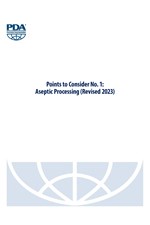Points to Consider No.1 Aseptic Processing (Revised 2023)
Premium Members: to claim your annual free technical document download, email membership@pda.org and indicate the document you wish to claim.
- Format
- PDF Single User
- Member Price
- $180.00
- Nonmember Price
- $325.00
- Government Price
- $180.00
Please sign in or become a member to purchase items from the PDA bookstore.
This document provides points to consider on topics related to the physical environment in which aseptic processing is conducted, monitoring of that environment, cleanroom personnel, material transfer, aseptic process simulation and validation, modern blow-fill-seal technology, cleaning, disinfection and sterilization, and critical utilities. It also includes points to consider on aspects of filter-integrity testing and water-for-injection (WFI) preparation. For additional information on specific topics, other PDA points to consider, technical reports, or similar documents are referenced. The recommendations presented in this Points to Consider document are based on five guiding and linked principles for improvement in sterile health care products:
- Scientifically sound, risk-based approaches should be used to obtain information needed to make decisions related to the evaluation, design, qualification, operation, and monitoring of sterile-product manufacturing processes.
- Where feasible, the use of newer technologies should be considered to mitigate or reduce risks to product quality identified in manufacturing processes and operations.
- The effectiveness of certain traditional testing and monitoring methods used as control strategies should be reevaluated. As technology has been introduced and knowledge has been acquired, the usefulness and value of testing procedures have changed. Testing and monitoring should be designed and performed, and the results should be evaluated, based on scientific value, risk to product quality, patient safety, and usefulness in determining process control.
- New product/container presentations, therapies, and technologies present challenges to existing methods for the development, manufacture, validation, and testing of sterile products. To meet these challenges, an emphasis on thorough technical and process understanding, science, and risk will become important in designing effective means to ensure product quality.
- When scientific approaches are similar and agreed upon, global health authority requirements and guidance should be consistent in technical language and definition.
Table of Contents
Table of Contents:
- I. Physical Environment
- II. Environmental Monitoring
- III. Validation (Aseptic Process Simulation)
- IV. Personnel
- V. Material Transfer
- VI. Cleaning, Disinfection, and Sterilization
- VII. Critical Utilities
About the Authors

